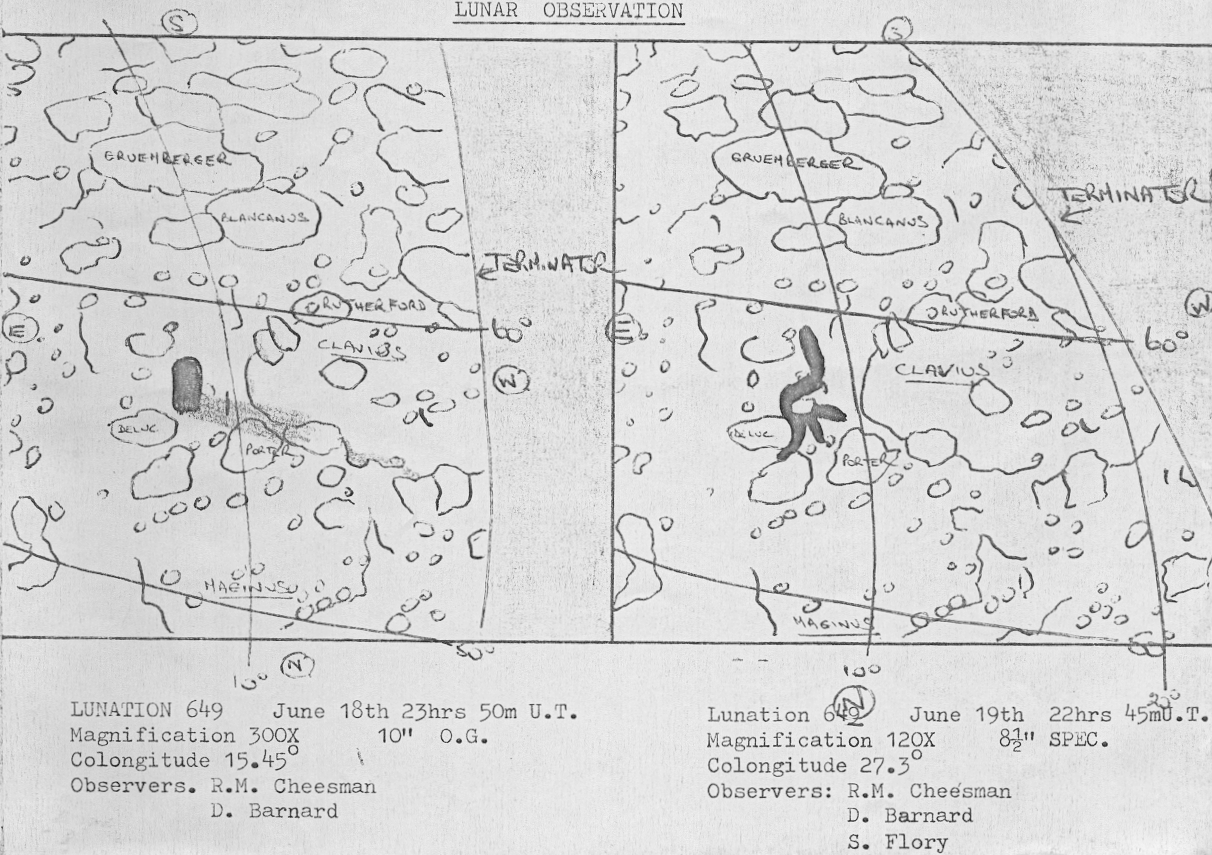
Orwell Astronomical Society (Ipswich)
Transient Lunar Phenomena, 21 February - 19 June 1975
A Transient Lunar Phenomenon (TLP) is any strange flash, glow or obscuration, lasting for seconds or longer, on the lunar surface. Members of the BAA Lunar Section have been interested in TLPs after they became "respectable" in 1958 when the Russian professional astronomer Nikolai Kozyrev obtained the first spectrograph of a TLP.
In the mid-1970s, the BAA Lunar Section ran a network of TLP observers throughout the British Isles with a few observers also in the Low Countries. If any observer witnessed a suspected TLP, he/she would set the observing network in action by telephoning the co-ordinating team at Mills Observatory1, Dundee. The co-ordinating team would then contact as many observers as possible (including experienced astronomers such as Patrick Moore) to make observations of the suspected TLP and to make drawings and take photographs and spectra.
During 1975, members of OASI observed suspected TLPs, as reported below. Unfortunately, ultimately none of these observations turned out to be of true TLPs.
During the period Friday 21 - Monday 24 February 1975, the BAA network of TLP observers was a hive of activity! A suspected TLP was observed on the Friday night and Saturday morning, and the network swung into operation. The suspected TLP was a short distance from the crater Aristarchus and its existence was confirmed by several observers. Howard Miles, who was alerted by the network, not only confirmed the TLP in Aristarchus, but discovered another TLP at the same time in the crater Gassendi, which other members of the network confirmed. The following evening there was another TLP: this time a blue colouration inside the crater Aristarchus. On the Monday evening, activity was still visible in the area of Aristarchus. Most observers were clouded out on the Tuesday evening.
The observing reports received by the BAA Lunar Section left little doubt that there had been major TLP activity in and around Aristarchus. Note that perigee and full Moon occurred almost together, the former at 22:00 UT on 25 February and the latter only three hours and 15 minutes later. The combined maximum gravitational influence of the Sun and the Earth on the Moon may have contributed to triggering the TLP.
At Orwell Park Observatory, three members of OASI, Charles Radley, Tom Cardot and Dave Barnard observed the suspected TLP in Aristarchus and submitted a report to the BAA. However, by February 1976, Charles had concluded that the suspected TLP had been, in fact, a false alarm. The OASI Newsletter in March 1976 advised members that a similar conjunction of perigee and full Moon would occur on 14 April 1976 and that the date might therefore be associated with further TLPS; however, no observations of the phenomenon were reported.
On the night of 18-19 June 1975, Royston Cheesman (OASI Chairman) and David Barnard were observing the Moon with the 26 cm refractor at Orwell Park. They saw, near the crater Clavius, a strange object which they described as looking like a ten-story block of flats. The object stood prominently, casting a shadow towards the crater. Roy and David, together with Stephen Flory, made another observation on the following evening using Roy's 210 mm reflector. Although the object was still visible, it had developed dark, radiating arms as though an eruption had occurred and lava had poured out. Shortly after 1.00am, after about half an hour of observing, the Moon had moved out of view behind a house, and in order to continue viewing, Stephen and Roy had to dismantle the telescope and move it together with its stand into the front garden. Roy and Stephen then contacted a member of the BAA TLP network, Commander Henry Hatfield. Commander Hatfield was having a cup of tea at the time, waiting for the clouds to clear over his observatory, and took the call.
If the object were merely a formation on the lunar surface, it should be visible again under similar conditions of illumination. These occurred on 16 August when, at 23:00, through a break in the clouds of a few minutes, Roy was able to observe the Moon again with his 210 mm reflector. Although conditions were not ideal, he concluded that the feature appeared still to be present.
Further doubt was cast by Patrick Moore on the likelihood of the object being a TLP. Roy sent his drawings of the object to Patrick for evaluation and received a reply to the effect that the feature was merely a depression which was not obvious in the usual way and which Roy and his colleagues had observed at a time when conditions were favourable.
[1]
Coincidentally, the Mills Observatory houses a refractor of similar size and vintage to that at Orwell Park.
John Deans